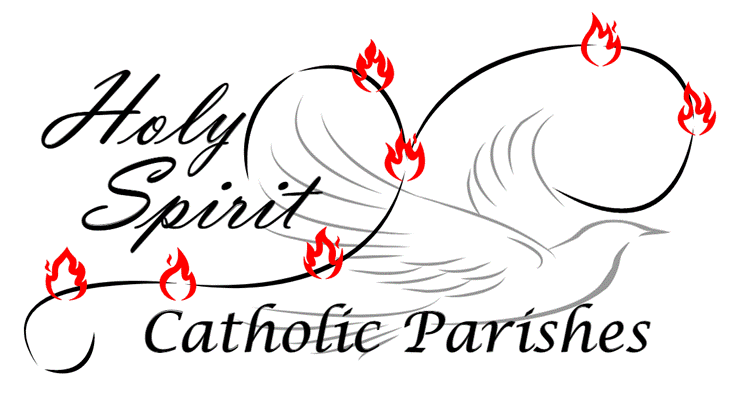History
History of Religious Sisters at Holy Trinity
The Convent
By Joan Burney
The Convent had a mystique about it. The Ursuline Nuns who first owned it called it “Ursuline Convent of the Nazareth.” When they departed and the Benedictines took over, it was renamed Holy Trinity Convent. The Sisters loved their convent. It was their home, and they were very much part of its mystique. It was a peaceful and prayerful place, the lawn beautifully manicured, gardens well tended with the statue of Our Lady presiding over all. It was also a place of joy, where visitors were greeted with open arms, laughter and love, and the smell of cookies or home baked bread often permeated the air.
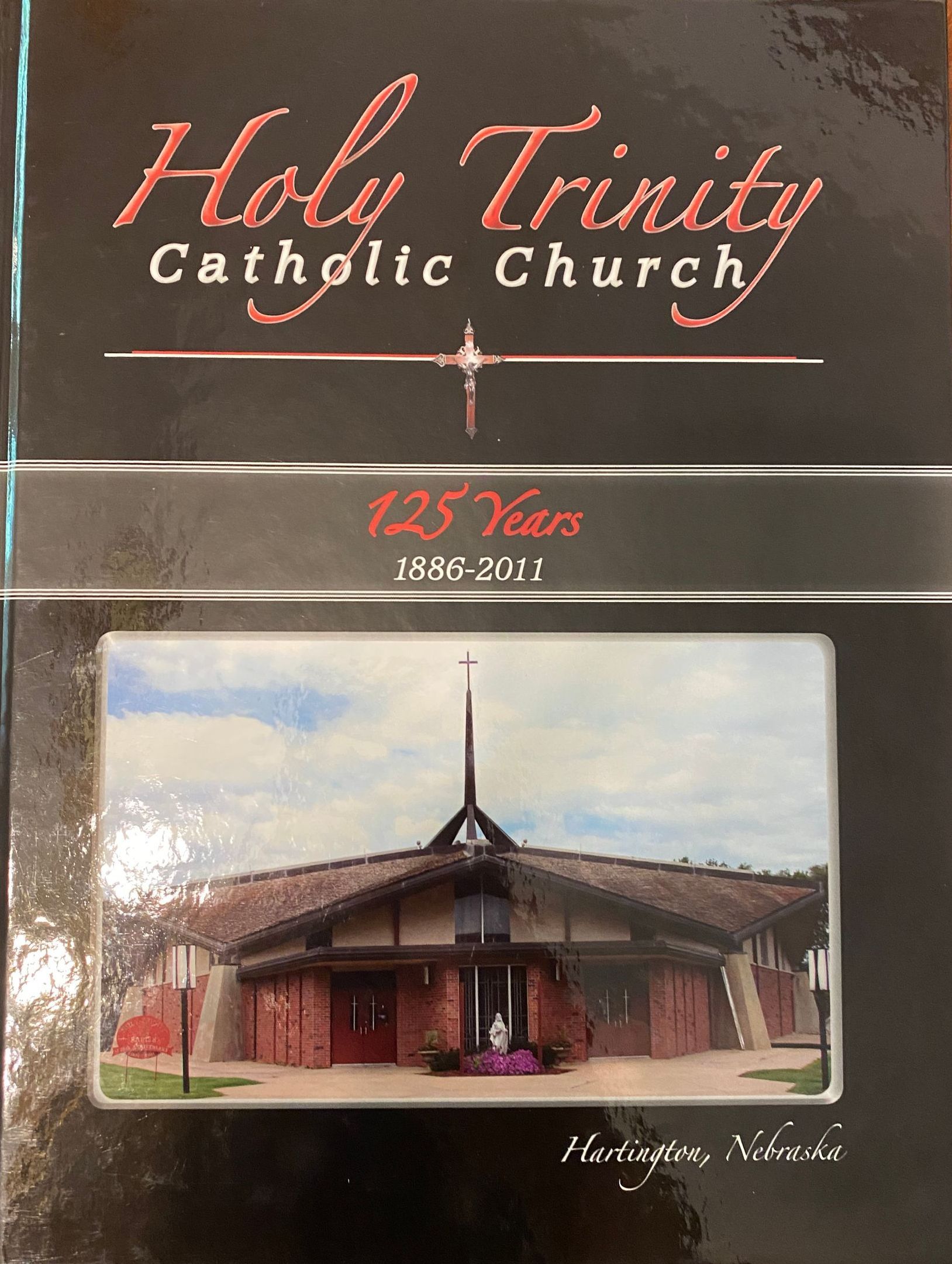
History excerpts from Holy Trinity Catholic Church, Hartington, Nebraska, 125 Years 1886-2011, p. 26-31.
The convent sat on a hill overlooking the school and Church, with the city of Hartington stretched out beyond. When the nuns walked down the hill to the school they most often walked in a group, with rosaries swinging from their belts and black robes billowing out behind. They were a formidable group, a powerful presence in our lives, and we respected them with all our hearts.
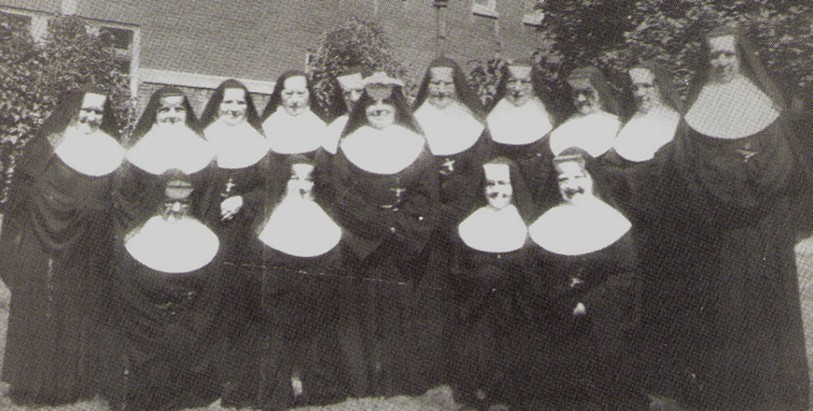
Ursuline Nuns
Left to Right: Sister Gerard, Crescentia, Antoinette, Louise, Rita, Agnes, Assumpta, Genevieve, Loretta, and Monica.
Front Row: Sister Loyola, Annunciata, Mother Ida, Colette, and Marcella.
As children we’d ponder for hours on how they would look without their habits. What color would their hair be? Or, though it didn’t seem likely, might they even be bald?
The new school, built in 1901, was the first home of the Ursuline Sisters who came to staff it. Part of the lower floor served as kitchen and dining areas. The third floor was used for bedrooms for the Sisters and boarders. It worked, but was not too comfortable. So it was a dream of the Ursulines to have a convent building separated from the school.
On June 15, 1908, that dream was on it’s way to becoming a reality.
The Ursuline Convent of the Nazareth received a deed from Fr. George Glauber, Pastor of Holy Trinity Parish, for land located in the southern part of Hartington. In October 1909, more land was added from August and Elizabeth Lubeley. In November of the same year, August Lammers deeded land to the Ursuline Convent.
Fr. Ferdinand Schnuettgen, who was Pastor from 1909-1930, witnessed the fulfillment of the dream of the Ursulines as they moved into their own personal Convent.
The first convent was constructed by moving two farmhouses together. It served as a living quarters for the sisters, a small chapel, and small dining room where the priest was served his breakfast after early morning Mass in the chapel. It also had a living room, a dining room for boarders, a kitchen, and a large unfurnished area used for storage and work activities. All this was on the first floor.
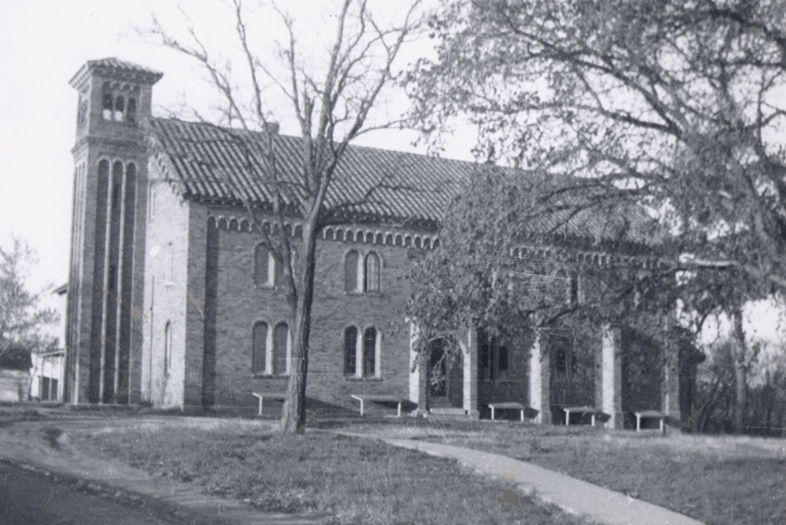
Convent
The second floor provided space for the bedrooms and a dining room for the Sisters. Food was brought up by a dumb-waiter. Also, there was an elevator in this area leading from the first to the second floor.
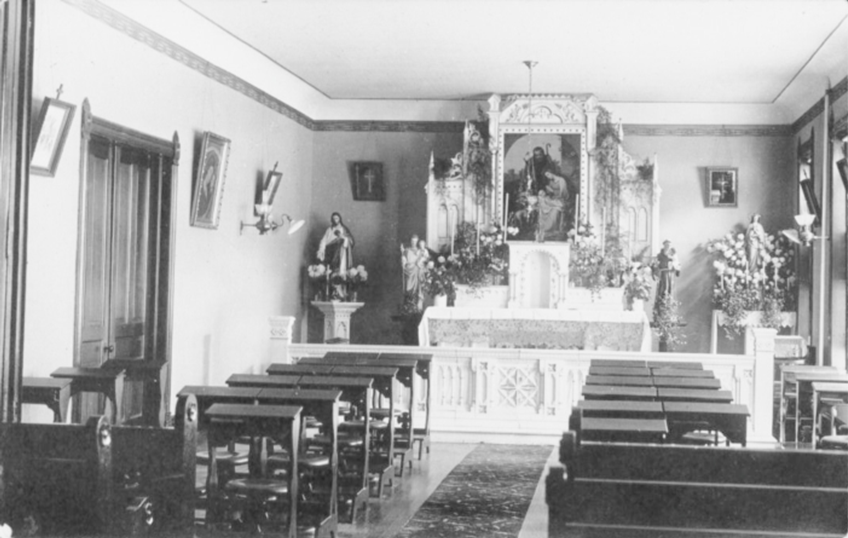
Convent Chapel
In 1932, when Msgr. Lordemann was Pastor, a new three-story wing was added to the convent. The older small chapel became part of the enlarged parlor. A new chapel and entrance hall were built, and the stairway was renovated. A bath and nine small cells for community sisters were provided on the second floor. A third floor dormitory was constructed to accommodate a dozen or so boarders. One of the entrances to the third floor dormitory was a circular stair in a tower on the east end of the building. Students who boarded there tell some interesting stories about secret trips up and down that circular stairway. They lived in a third floor dormitory, their beds divided by curtains on rods, which could be pulled at night for privacy.

Young women who stayed at the convent.
Vera Foster Peitz, 1945 graduate, spent two years as a “boarder.” She said they attended Mass in the Convent Chapel, ate breakfast, and then went to Mass in Church with the rest of the students. They also ate lunch at noon and dinner in the evening at the Convent. During the evening they sat on the porch and visited, played games outside, or studied. They were closely supervised, says Vera, but when the lights went out at night, “All kinds of interesting things happened.” Pillow fights, for instance.
The new part of the convent was a Spanish style, brick veneer and frame structure, which was built at the cost of $20,000.00 with funds provided by the relatives of one of the Ursuline Sisters. Bill Israelson was the contractor. The Convent, built on a hill overlooking the Church and the school, was named Mount St. Joseph.
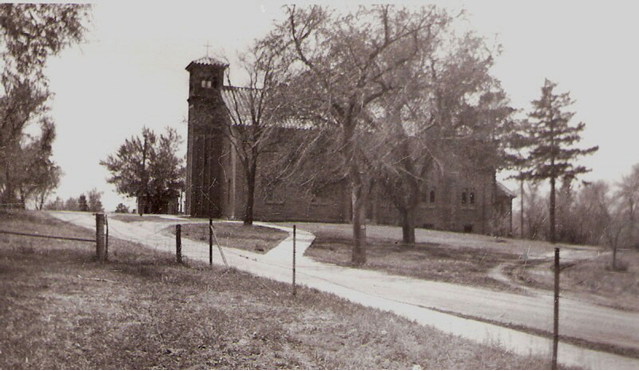
Since the Ursuline Sisters owned the property and lived at the convent year round, the grounds were landscaped and well kept. The sisters had a number of beef cattle and a smaller number of hogs to supply meat for themselves and their boarders. They also kept chickens and milk cows. In addition, they had a large garden and orchard, which yielded many kinds of vegetables and fruit. The Ursulines employed two or three men to run the little farm. They themselves helped with the garden work and the milking.
In August of 1943, in order to concentrate on larger schools and academies, particularly in the East, the Ursuline sisters left Nebraska. They left not only Hartington, but also their Motherhouse in York, Nebraska.
The Benedictine Sisters of Sacred Heart Convent of Yankton, South Dakota, responded to Msgr. Lordemann’s plea for sisters to continue staffing the Parish grade school and high school.
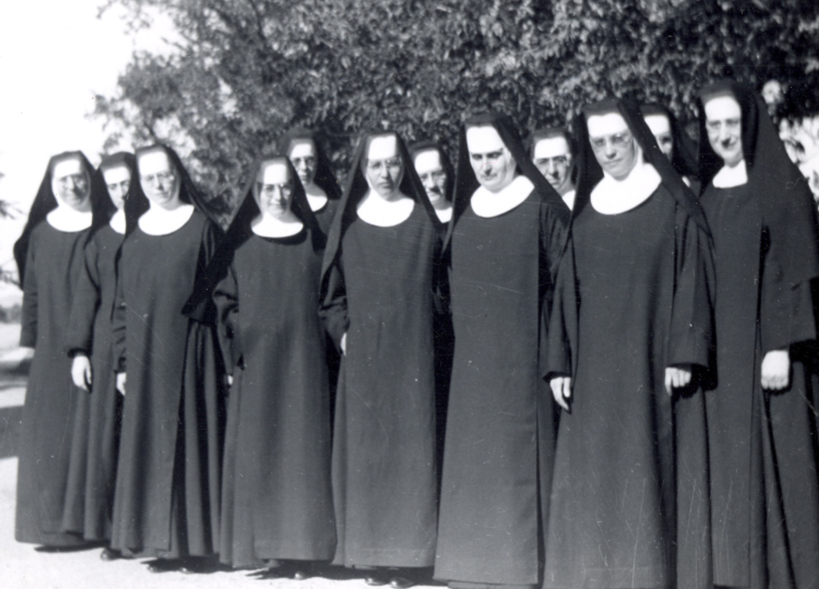
Benedictine Sisters
Upon arrival, the Benedictine Sisters were impressed with the spacious grounds, the stately pine trees, the grotto of our Lady and the lily pond. It was a beautiful setting, conducive to the quiet and prayer-life of the sisters.
In 1951, the Ursuline Province deeded the property to Holy Trinity Catholic Church for $1.00. (Later some of the land was sold to the Hartington Public School.)
The home was renamed Holy Trinity Convent. It remained as it was until the fall of 1963, when part of the original frame building was replaced by a two-story brick building that was added to the 1932 structure.
Changes and improvements were constant, and became a part of the total History of the Holy Trinity Convent. In 1944, it was necessary to re-shingle the old part of the Convent. In 1945 the well gave out and pipes were laid to connect it to the city water supply. In 1954, a new gas range replaced the large ancient cook stove that the Ursulines had been using, most likely since the beginning.
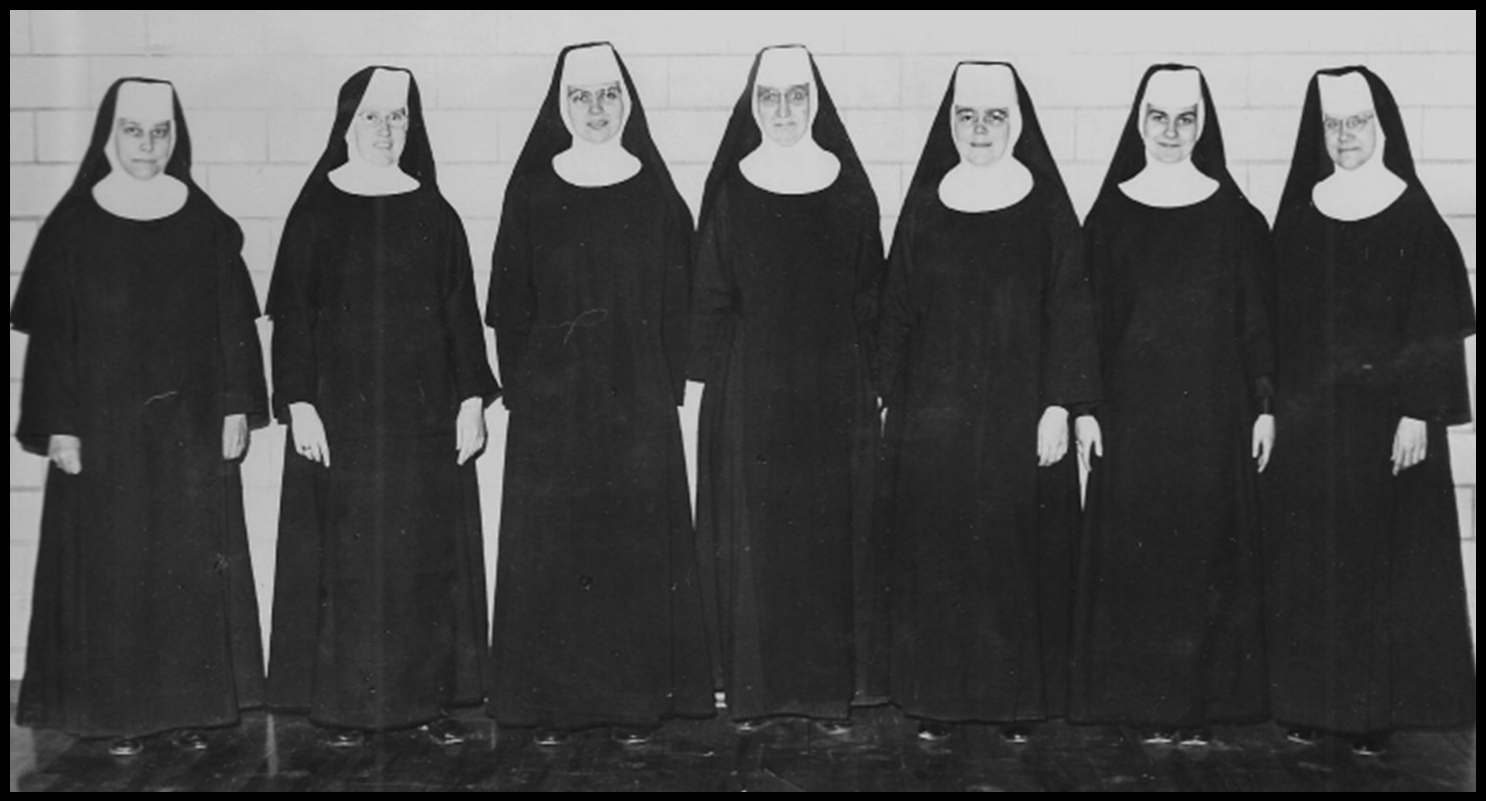
1964 Holy Trinity Benedictine Nuns.
In 1960, the Benedictine Staff had increased to 15 sisters. It was necessary, therefore, to take over part of the third floor dormitory, no longer used for boarders, and divide it into private cells, making it possible for each sister to have her own private bedroom.
In 1963, during the time Fr. Raymond Auer was Pastor of Holy Trinity, other changes and renovating needed to be done. The original part of the building had seen its best days, and so it was razed and replaced by a new structure. The Hoesing Construction Company was employed to build a new kitchen and dining room on the first floor, plus a small guest lavatory, and a workroom.
Above the dining room was built a spacious community room and above the kitchen, new shower facilities, lavatory, small guest bedroom, and a hall leading to the 1932 addition. Attached to the workroom on the first floor, a garage was also added. The new brick building, which was an addition to the south of the older structure, blends in with the Spanish architecture of the front (north) part of the Convent.

Convent with Grotto. Learn more about the Grotto.
In 1985 it was decided that the convent needed a complete renovation. The idea was to make the convent more economical to heat, and to make it into a more compact unit, providing a better living quarters for the nuns who resided there at that time. The entire west side of the convent, most of the 1932 addition, was closed off. This included the chapel and the basement. The entrance room was remodeled into a cozy chapel, which the sisters said was “very nice.” The former community room was remodeled into three bedrooms.

Sisters Appreciation Program May 1994.
Only six Benedictines resided in the convent in 1985. With the dwindling numbers of teaching sisters, and the changes that had come about in education, it was more difficult to staff the schools. Those sisters taught, and worked with the lay people and the priest in many Parish activities, living up to the motto of St. Benedict, “Ora Et Labora” (Prayer and Work).
In the following years, the number of nuns continued to dwindle, until there was just Sister Rose, and finally no sisters at all. The Convent became a building without a purpose. The question of what to do with the convent was debated and debated. Just the cost of insurance on the old building was formidable, let alone the continued upkeep.

Sisters Rose, Elmera, and Vera.
For some, it seemed an ideal place for the city library, others thought it would be a perfect picturesque place for a bed and breakfast, still others a childcare center. The ideas were numerous, but the bottom line was no one came forward who could afford to renovate the old building. There just weren’t any buyers and it would be too expensive to maintain just for sentimental reasons. The Convent contents were sold at auction, and on Wednesday, February 19, 1998, the Hartington Fire Department was solicited to burn it down. The blaze was started at 4:20 p.m. and it was still smoldering the next morning. Fire Chief Gerald Fischer stayed all night to make sure the fire did not get out of hand. It was the end of an era.
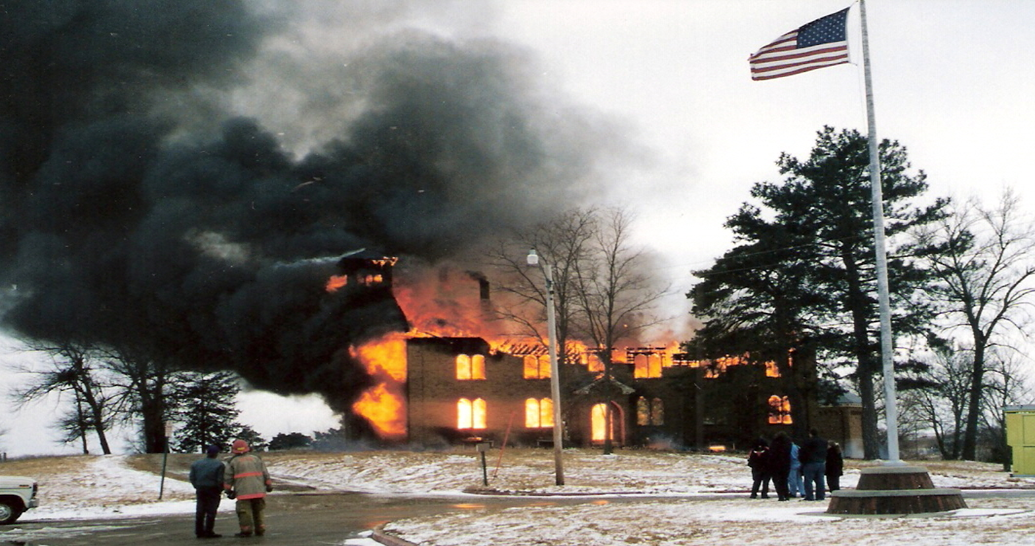
Convent burned in 1998.
Many a tear was shed as the noble old building went up in flames. It is comforting to know it will live on in our memories, and will come alive in this history book for generations to come.
The Sisters of the Presentation of the Blessed Virgin Mary
The Sisters of the Presentation of the Blessed Virgin Mary were founded in Ireland, in 1775, by a woman named, Nano Nagel. She was from a wealthy family and was extremely disturbed by the Catholic children who were not being educated because of the laws of the time.
Nano founded seven schools around the city of Cork, Ireland, to educate the children in their Catholic faith as well as teach them to read and write. Back in that time, there were no sisters that left the convent to work with the people. She did not want this for her sisters because they would not be able to work with the poor of Ireland or the world.
In 1875, a group of four sisters came from the village of Mooncoin, Ireland, and started community in Dubuque, Iowa, on November 13, 1875. The group of sisters then made their place of residence in Key West, Iowa. In February, the rectory in Key West became available so the sisters moved in. They started their first Catholic School, teaching in the living room of the rectory. Thirty students attended the first year. Later the public school next door became available and the sisters moved in there. Today the Dubuque Presentation Sisters serve around the United States and in the country of Bolivia, teaching in schools from elementary to college. They work in parishes, food pantries, hospitals and other places. The mission of The Sisters of the Presentation of the Blessed Virgin Mary is to work with the poor and places where the Gospel needs to be proclaimed.
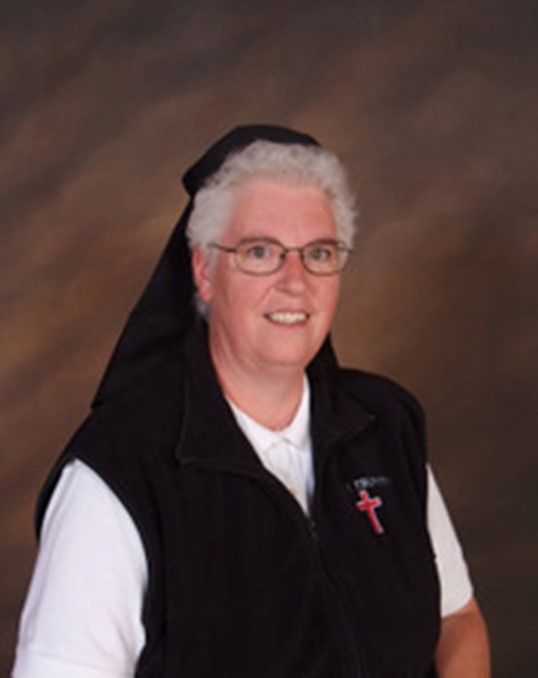
Sister Jane Conrad
Sisters of the Presentation of the Blessed Virgin Mary
2006-present
Sr. Jane came to Holy Trinity Parish in 2006 and worked in the Parish office as the receptionist. The following year she was asked to work at Holy Trinity School to help students who were high achievers. She also began the reading fluency program with grades 2-6 at Holy Trinity Elementary each week to help students read more smoothly and improve their speed.
Her duties broadened to help with liturgical seasons beginning with Lent in 2008. Sr. Jane is the coordinator of the all-school activities through the weeks of Lent and Advent including daily reflections and Stations of the Cross. She assists the classroom teachers to work with the students and tie in to the themes of each daily reflection.
In 2011, Sr. Jane worked more with Kindergarten class because of the number of students. Most of her day is with them, teaching reading/writing/phonics and math. She has also been working with 5th grade as well to give students one-on-one help as needed. “I truly enjoy working with students and faculty at Holy Trinity because of the high expectations and high a quality atmosphere in the school.”
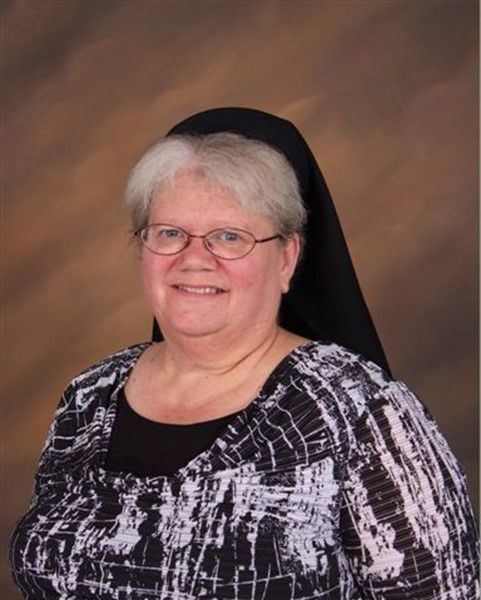
Sister Brigid Stanley
Sisters of the Presentation of the Blessed Virgin Mary
2004-present
Sr. Brigid began teaching at Cedar Catholic in 2004 after meeting Fr. Pietramale in 2003. Sr. Brigid has taught Jr. High Religion and Science (life and earth science) as well as 9th grade Physical Science. She also taught 6th and 7th grade religion in the CCD program. At St. Michael's Parish, Sr. Brigid taught CCD for 2 years and is an EMHC and lector. "It is a pleasure to serve here. The reverence for family shown by the Parishioners is a great gift as is being close to my own family in Northeast Nebraska."
